Renaturation of the Romanche
Five dams removed, 40% more electricity: a turning point for both the environment and energy
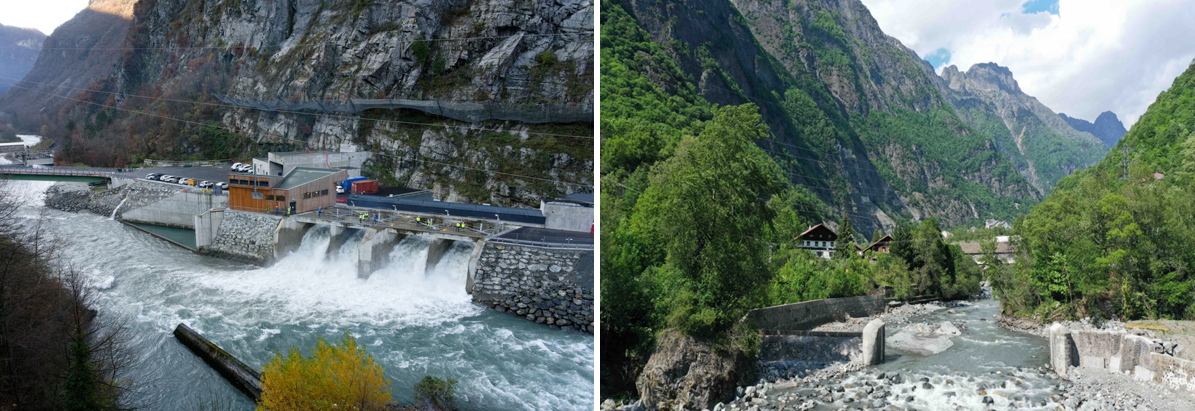 Gavet restitution platform and power station (©EDF, Christophe HUET) and dismantled Clavaux dam (©Roberto EPPLE)
Gavet restitution platform and power station (©EDF, Christophe HUET) and dismantled Clavaux dam (©Roberto EPPLE)
Resume :
The Romanche is an alpine river that has been exploited for many years for electricity production, which has led to significant artificialization of the riverbed. In response to environmental issues and the dilapidated state of existing structures, several reconfiguration and dismantling projects have been carried out in recent years. These include the Séchilienne dam, built over 100 years ago and dismantled in 2018, and the network of structures between Gavet and Livet, five of which were replaced with a more efficient structure.
Inaugurated in October 2020, the Romanche-Gavet project replaces six power plants and five dams with a new water intake dam (Livet) and a hydroelectric power plant (Gavet) located approximately 10 km downstream, with a head of 163 m, as well as a 9.3 km water intake gallery dug into the mountain beneath the Belledonne massif. The five structures were dismantled between 2021 and 2023, freeing up nearly 10 km of surface area.
In addition to restoring ecological continuity and habitats (estimated at 1 hectare of former reservoirs), the project aims to renature the valley. Several brownfield sites, including former hydroelectric power plants, were dismantled to free up 4 hectares of space and improve the local environment, thus revitalizing the previously abandoned valley. Several projects to enhance the sector are underway. This project demonstrates that it is possible to increase energy production while restoring ecological continuity, paving the way for the valley’s revival.
The Dismantling of the Séchilienne Dam
The Séchilienne Dam was built around 1917, during the First World War, initially for the production of poison gas. It was later used to generate electricity to power the Noyer Chut factory. However, with the diversion of the Romanche River in 1946 for the Vizille Péage factory, the dam’s energy production declined significantly. Furthermore, the factory was located in a landslide-prone area, making its continued operation unnecessary.
In 2009, the State acquired the infrastructure associated with the factory, including the dam and the intake canal. Between 2010 and 2013, the Isère Departmental Directorate of Territories (DDT) demolished the factory, filled in the canal, and removed the gates that regulated the water level. This dismantling is not only for ecological reasons, but also for safety reasons, particularly with the filling of the intake channel to prevent the risk of falls and the removal of the valves, which, without power, could accidentally close.
Funding for the project comes from several sources, including the French government, the Rhône-Alpes Region (which became Auvergne-Rhône-Alpes in 2016), the ERDF, and the Rhône-Mediterranean-Corsica Water Agency.
Equipment of the new Romanche-Gavet hydroelectric infrastructure
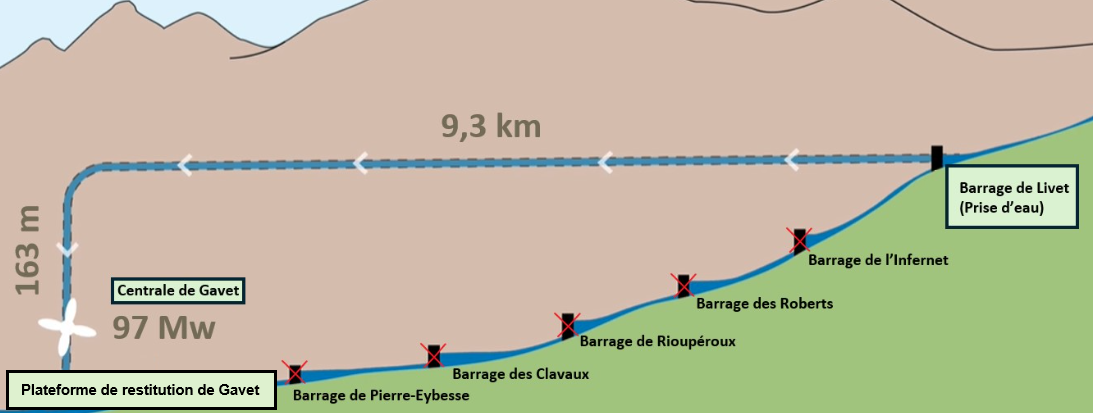
The Livet water intake dam captures water from the Romanche River and conveys it to the Gavet underground power plant. The dam diverts a maximum flow of 41 m³/s. To preserve the aquatic ecosystem and fish life, a minimum flow of 3.8 m³/s is left in the diverted section, or 1/10th of the module. The water passes through an intake equipped with grates and a screen before entering the gallery. This gallery transports the water under pressure to the power plant. It then passes through a stabilization chimney to stabilize the pressure. At the outlet, the water drops 163 meters into a penstock that powers two Francis turbines to produce up to 97 MW of electricity. This power plant produces 560 million kWh per year, 40% more than the old facilities, which covers the annual consumption of approximately 230,000 inhabitants. For information purposes, this is equivalent to the population of the cities of Grenoble and Chambéry. The underground installation of the infrastructure limits the visual and ecological impact.
Deletion of 5 works on the Romanche
As the 5 structures between Livet and Gavet are no longer in use, they were dismantled between 2021 and 2023. The Clavaux dam was leveled and a bottom sill was created to stabilize the bed, mitigate the risk of erosion and allow the passage of migratory fish. The removal of the aging dams will restore the ecological continuity of the watercourse over around ten kilometers, improve water quality and encourage the resumption of natural sediment transport. Aquatic habitats and the natural functioning of the river will be restored on this section.
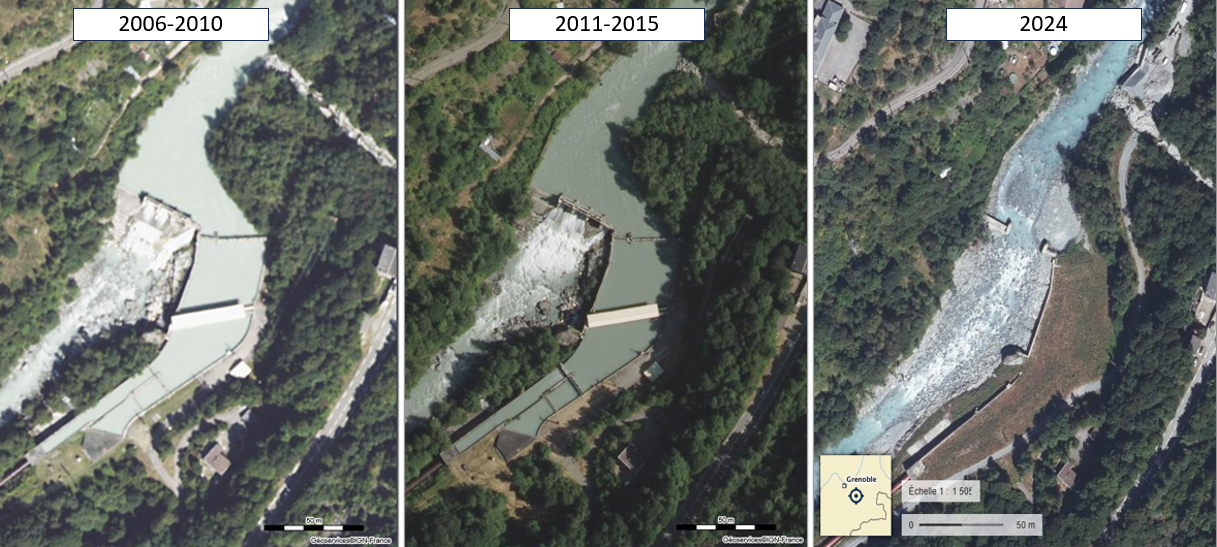
©IGN – ©Géoportail, Clavaux site
Feedback on the renaturation of the valley
The project not only restored ecological continuity and natural habitats, but also transformed the valley’s landscape. Several brownfield sites, including former hydroelectric power plants, were decommissioned, freeing up 4 hectares and improving the living environment for local residents. The Vernes power plant, a listed historic monument, was preserved. The Rioupéroux and Livet sites are still under review for their future. Other redevelopment projects, particularly for the hamlet of Rioupéroux, are also under consideration.
To restore the riverbanks, stabilize the soil, and promote biodiversity, more than 8,350 shrubs and 500 kg of local seeds certified “Végétal Local” were planted by the National Forestry Office.
The renatured valley offers new opportunities for enhancing its natural and historical heritage. A 9 km trail has been created in the gorges of the middle Romanche, retracing the hydroelectric past of the site and connecting the different hamlets by following the course of the river. Finally, the Romanche Museum in Rioupéroux allows visitors to discover the industrial history and the major stages of the transformation of the valley.
To go further
Localization
The Romanche River rises at the Plate des Agneaux glacier, located in the commune of Villar-d’Arêne in the heart of the Écrins massif. It crosses the Hautes-Alpes and Isère departments in the Provence-Alpes-Côte d’Azur and Auvergne-Rhône-Alpes regions. Its 78 km long course ends at its confluence with the Drac, between the communes of Champ-sur-Drac and Varces-Allières-et-Risset at an altitude of 257 m.
The five former dams and three former hydroelectric power plants of the Romanche River were spread along the valley between the Gavet power plant and the Livet intake dam in Isère.
Numerous obstacles still remain on the Romanche River, including the new Livet intake dam equipped with a fish pass. However, the restoration work has made it possible to re-establish the circulation of fish between the Peyron water intake and the Clapier dam, thus re-establishing fish continuity over 37 km.
New Romanche-Gavet power station
– Power: 97 MW
– Annual production: 560 million kWh (40% more than the five previous installations)
– Height: 163 m
– Length of the intake tunnel: 9.3 km
– Equipment: 2 Francis units running at 500 rpm
The Livet water intake dam

© EDF
– Type: Movable gate dam
– Height above riverbed: 6.3 m
– Total width: 43.7 m
– Equipped with a 24-basin fish pass
– Reservoir volume: approximately 180,000 m³
– Reservoir length: nearly 2 km
– Maximum flow diverted to the intake gallery: 41 m³/s
– Reserved flow: 3.8 m³/s




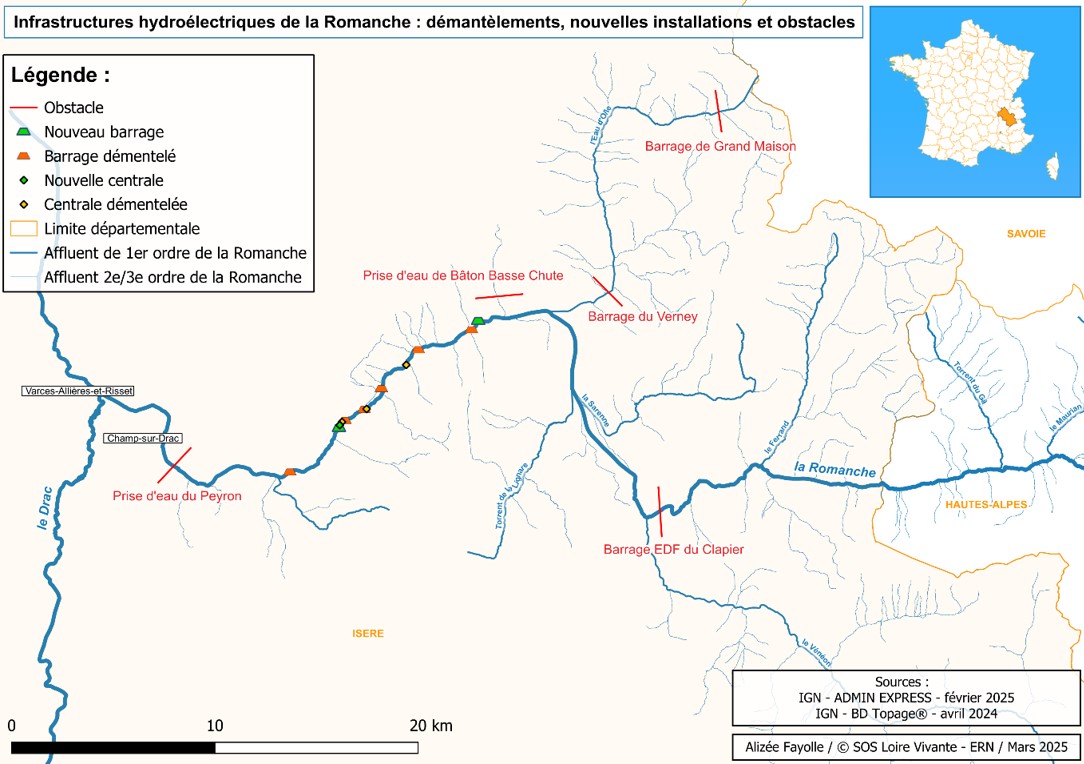
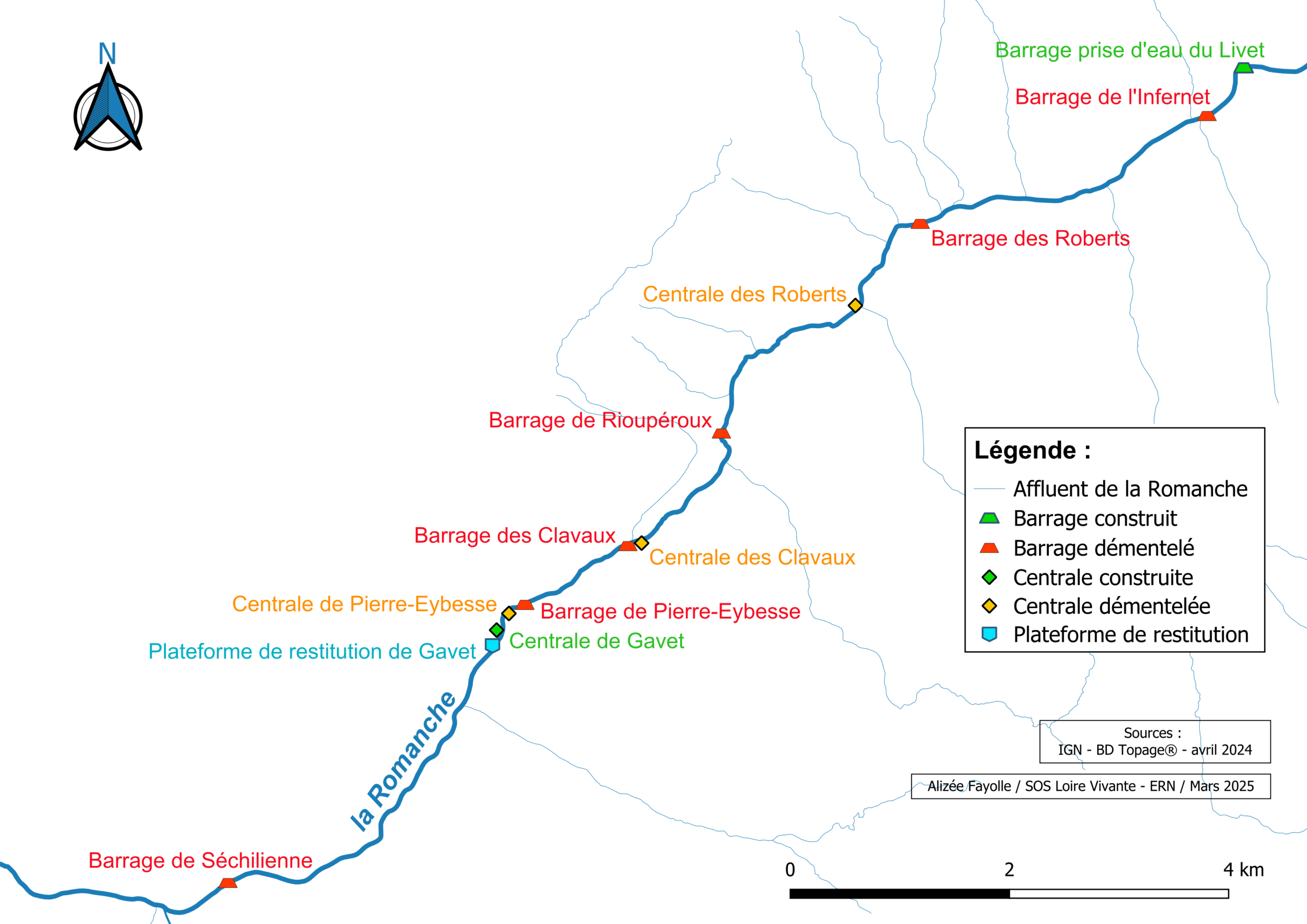
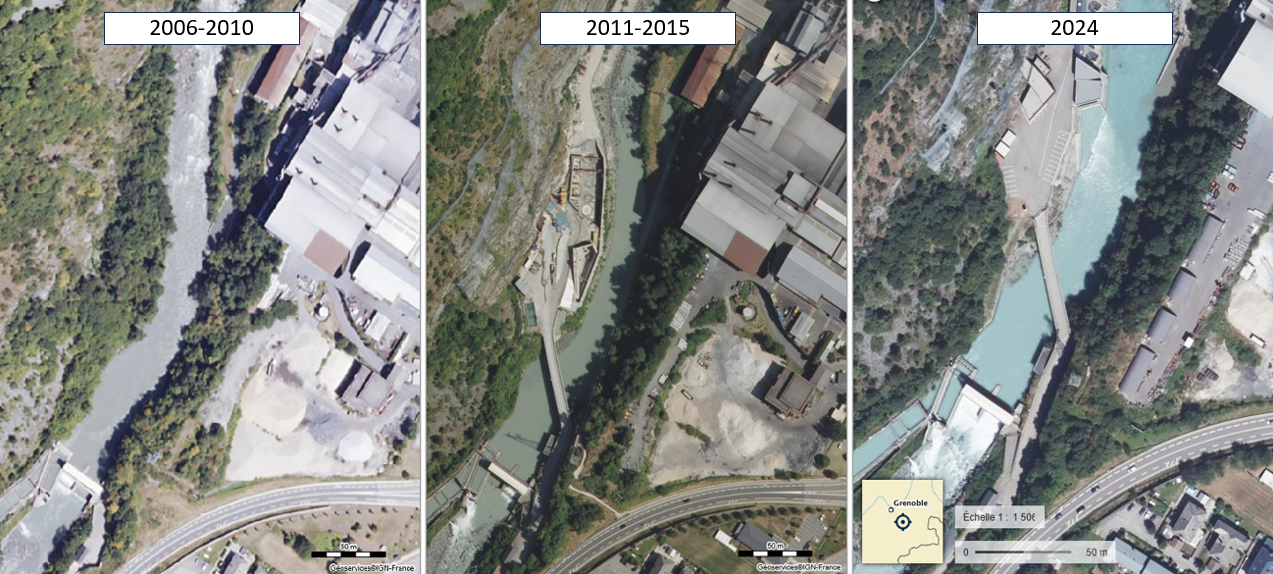
 ERN France
ERN France ERN is the official WWF Freshwater Partner in France and cooperates with WWF Switzerland, Austria, Netherlands and others
ERN is the official WWF Freshwater Partner in France and cooperates with WWF Switzerland, Austria, Netherlands and others